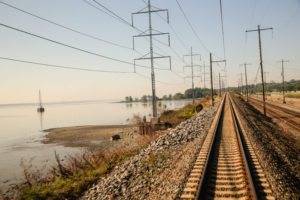Nearly $145 million investments for Amtrak owned Connecticut River Bridge and CTDOT owned Walk (Norwalk) Bridge Replacement
WASHINGTON – The Federal Railroad Administration (FRA) has awarded two FY20 Federal-State Partnership for State of Good Repair grants to Amtrak and Connecticut Department of Transportation (CTDOT) to help repair and rehabilitate railroad infrastructure and other assets in the state of Connecticut as part of the ongoing Amtrak and CTDOT partnership. Totaling nearly $145 million, the two grants will lead to the replacement of the Amtrak-owned Connecticut River Bridge Replacement project, which will receive $65.2 million, and the CTDOT owned Walk Bridge replacement project will receive $79.7 million, which will eliminate slow orders, and raise the maximum speed at which trains can travel along the bridges.
“We are pleased to receive these grants from the FRA, as they highlight our joint commitment to infrastructure investment and improvement,” said Amtrak President and CEO Bill Flynn. “We thank the FRA, CTDOT, and our state and NEC partners for their hard work and collaboration in awarding us these grants, which will benefit the local and state economies and our customers with improved reliability.”
“This $145 million in grants will provide Connecticut with the urgently needed funding to replace both the Walk Bridge and Connecticut River Bridge – vital structures that have long outlived their intended lifespans. Rail passengers along the Northeast Corridor deserve speedy and reliable service on Amtrak, New Haven Line, and Shoreline East. I will continue to fight for every federal dollar for Connecticut’s rail and transportation infrastructure to help grow our state’s economy,” said Senator Richard Blumenthal.
“The U.S. Department of Transportation funding we secured today is big deal for Connecticut. The Walk Bridge and the Connecticut River Bridge are both over a century old, and they are major chokepoints on the Northeast Corridor—affecting travel within our state and well beyond our borders. Connecticut’s economic competitiveness depends in large part on its connection to Boston and New York. This funding represents a big step towards modernizing the Northeast Corridor, and I will continue to work to protect and enhance Connecticut’s transportation infrastructure,” said Senator Chris Murphy.
“The Walk Bridge is a critical juncture for commerce traveling along the East Coast. But, for too long, we’ve been trying to accommodate a 21st Century economy with 19th Century technology. Securing these funds has been a top priority of ours because we need critical infrastructure investment to keep Connecticut thriving and competitive for years to come,” said Congressman Jim Himes.
“Investment in our aging infrastructure is imperative to maintain and improve reliable, quality rail service for our customers,” Connecticut Department of Transportation Commissioner Joseph Giulietti said. “And those customers in turn, are critical in supporting the economy of the state and the region. I am gratified that by working in conjunction with AMTRAK, FRA, NEC and our congressional delegation, that we have received substantial federal grant assistance toward the replacement and upgrade of these two aged, yet essential bridges on our mutual rail corridor.”
The Connecticut River Bridge, which is located between Old Saybrook and Old Lyme, CT and carries Amtrak and Shore Line East trains, will undergo a full replacement. This includes a new design along a new alignment parallel to and south of the existing bridge that improves reliability and offers higher speeds for Amtrak and Shore Line East trains, submarine cable relocation and construction of retaining walls and a new alignment for the embankment. Completed in 1907, it is the oldest movable bridge between New Haven, CT and Boston, MA. The current bridge has a movable span that is raised up to allow boats to pass, and the new bridge will also be movable with improved and unlimited vertical clearance as well as navigation enhancements in the main channel. By law, the bridge must remain open from May through September for recreational boats to pass and closes only when trains approach.
The federal funding will be used to replace the existing movable Walk Bridge in Norwalk, which was built in 1896 and has recently experienced increasing deterioration of electrical and mechanical components. The new bridge will include two movable spans carrying two tracks each, which can operate individually in the event of a necessary track outage, new approach embankments and retaining walls, installation of new catenary structures, and signal system upgrades. Construction will require an extended continuous outage of two tracks, while the other two tracks will remain operational. This change in track availability could cause changes in schedule, decreases in reliability, or even reductions in service. Two additional projects in the vicinity of Walk Bridge will help address these concerns; the new CP243 interlocking will shorten the block length between Westport and Norwalk while increasing operational flexibility; and improvements at Dock Yard and the electrification of the lower Danbury Branch which will allow for Metro-North trains to turn at Norwalk without increasing congestion on the main line of the NEC.
This work is included in the Northeast Corridor Commission’s five‐year capital plan as a regional priority. To learn more about these and other critical infrastructure projects Amtrak is working on, visit nec.amtrak.com/readytobuild/ [1].
